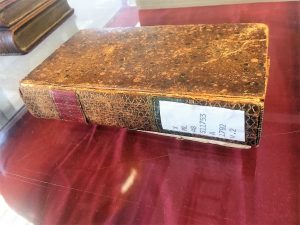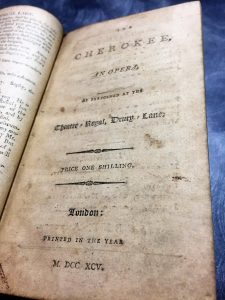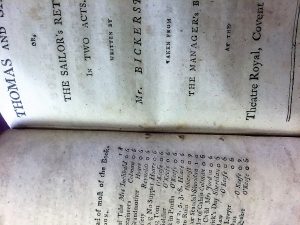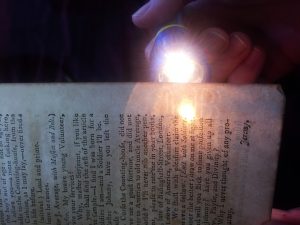This week, we were tasked with the physical examination of a book of our choosing from the special collections. I ultimately decided on a book from 1792 that was a bit different than the other books I’ve looked at to this point.

This book has a beautiful brown and black speckled cover, with a small leather strip on the spine imprinted with the gold-filled word “Farces.” The library’s digital catalog titled this as A collection of the most esteemed farces and entertainments, performed on the British stage. I know this because I could hardly make out the title on the spine itself, and when I went to look for a title page, I was abruptly met with the first page of a short play, and consequently turned to the internet to provide me with the title of the book as a whole. I also noticed that there was no publication or printer information within the book itself either.
What kind of book, even a book of plays, wouldn’t have this kind of information? Isn’t that what makes a publication? Also, when I began to examine the paper from each play, I noticed that each one had a different type of paper: some laid paper with horizontal chain lines while others woven paper with outer-edge watermarks. Even the text font wasn’t uniform between plays, although size looked pretty consistent.
I had to investigate.
The first thing I thought to do, after speaking with my library’s special collections librarian, was reach out to Professor Pauley about this. Given that this is a distance learning course, the only way I could approach him about this prior to my blog posting was via a hasty and vague email, to which he responded with his best guess: this may be a sammelband. A sammelband is a collected volume in which separately published pieces are bound together. My special collections librarian was also interested in this book, and told me that some printers, especially ones who were also book dealers, would often take requests for custom bindings. I, what with my precious little, still developing, knowledge of bibliography, eagerly bought into this suggestion. Only after further discussing this with Prof. Pauley, following his own light research into the matter, was he able to retract his initial suspicion, specifically since he was able to find another set of Farce volumes that appear to be identical to mine. A book of farce is characterized as one that aims to entertain its readers with exaggerated, extravagant, and improbable situations, typically with comedy.
I hope to look more into this at another point in the semester, and hopefully update this post with some more detail and information!

For the purpose of this assignment, I chose one of the farces in this book to work with. This play is titled “The Cherokee: An Opera.” While I didn’t have to read it for this assignment, given the year it was written, its title, and its farcical genre, I’m not too disappointed about that.
Binding
When first looking at the binding, I’d consider it very well preserved for being 225 years old, save the back cover that is completely unattached. I’ll admit that there was more than one instance during my visit with this book that I’d picked it up and quickly realized I’d left the back cover behind…
There is also clear evidence of stab stitching, which makes sense considering that these plays were of distinctly separate origins, and were likely stitched together without covers before being put into this collection. The pages are all neatly trimmed, and the margins are tighter near the binding than at

the outer edge.
Paper
For the play that I was working with, specifically, the paper was wove, and there was one instance of a watermark that I could see. In fact, all of the plays in this collection that were on woven paper had evidence of watermarks, while none of the laid paper did. The library I was working with didn’t have an available backlight for me to use to find these watermarks, but offered me a small flashlight that I could hold up to it while I snapped a picture with my phone.

As you can see, the watermark in this play lies closest to the outer edge. This play also has signatures at the bottom center of some pages in the pattern of A, A2, A3, B, etc.
Given that fact as well as the fact that the laid paper plays have horizontal chain lines, I’d be comfortable concluding that the format of this play is duodecimo. Based on this format, I’ve calculated that two sheets of paper went into the copy of this play:
48 [total pages] / 2 = 24 [leaves] / 12 [duodecimo] = 2 sheets
Given that it cost one shilling, and any printers were likely trying to keep costs down for producing a mere farcical play, this result makes a lot of sense!

